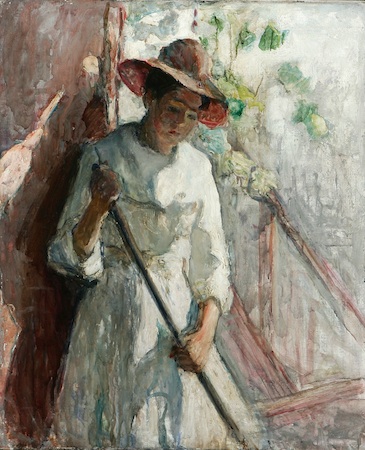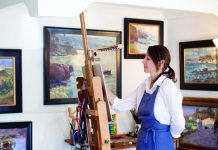
The average museum or gallery goer spends less than a minute sizing up a painting. That’s enough time to take in a toothpaste commercial or maybe a movie poster. It certainly isn’t enough to catch the nuances of a painting such as Clarence Hinkle’s “Outdoor Still Life,” a complex composition in the current Laguna Art Museum exhibition with several pictorial, light and perspective elements and a shifting picture plane.
On Thursday, June 28 at 6 p.m. art critic and author Peter Clothier will assemble a group of no more than 20 art lovers to study one painting from the current Hinkle exhibition for an entire hour.
An hour seems like an interminable stretch of time to devote to just one painting but Clothier says the process allows participants to experience a painting to the fullest. “The process is silent, with only minimal instructions from me helping walk people through a painting with their eyes,” he said.
He tends to begin at a painting’s outer edges, examine its impact on its surroundings and vice versa and then move into its narrative or representation, studying colors and patterns.
The exercise is neither lecture nor art criticism but about urging his audience to divest themselves of preconceptions and honing concentration, the art of freeing their vision and committing images to the mind’s eye.
Clothier came upon the process when he started meditating 10 years ago. Meditation helped him to contemplate painting at greater depth and he soon found like-minded art lovers intent on augmenting their viewing experiences.
Clothier’s meditative, silent method of teaching how to see differs somewhat from artist Hedy Buzan’s museum tours during “Slow Art Day,” an event designed to get people to slow down and view several works of art (sometimes of their own choosing) at a contemplative pace. While Buzan invites intermittent comments, Clothier’s group remains silent throughout, save for minimal instructions.
Both techniques call for a meditative, emotional approach along with more careful dissection of a work’s elements. “I am hopeful that people will come away with a sense that it is useful to pay attention to the rest of their lives,” said Clothier.
Reservations: Emily Poliakoff, 323-661-6349 or visit www.peterclothier.com .




